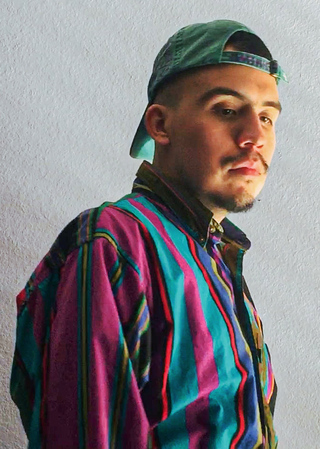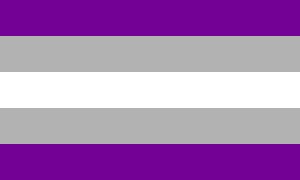
Romantic orientation, also called affectional orientation, is the classification of the sex or gender which a person experiences romantic attraction towards or is likely to have a romantic relationship with. The term is used alongside the term "sexual orientation", as well as being used alternatively to it, based upon the perspective that sexual attraction is only a single component of a larger concept.

Asexuality is the lack of sexual attraction to others, or low or absent interest in or desire for sexual activity. It may be considered a sexual orientation or the lack thereof. It may also be categorized more widely, to include a broad spectrum of asexual sub-identities.

A pride flag is any flag that represents a segment or part of the LGBT community. Pride in this case refers to the notion of LGBT pride. The terms LGBT flag and queer flag are often used interchangeably.
Over the course of its history, the LGBT community has adopted certain symbols for self-identification to demonstrate unity, pride, shared values, and allegiance to one another. These symbols communicate ideas, concepts, and identity both within their communities and to mainstream culture. The two symbols most recognized internationally are the pink triangle and the rainbow flag.

Demisexuality is a sexual orientation in which an individual does not experience primary sexual attraction – the type of attraction that is based on immediately observable characteristics such as appearance or smell and is experienced immediately after a first encounter. A demisexual person can only experience secondary sexual attraction – the type of attraction that occurs after the development of an emotional bond. The amount of time that a demisexual individual needs to know another person before developing sexual attraction towards them varies from person to person. Demisexuality is generally categorized on the asexuality spectrum.

The following outline offers an overview and guide to LGBT topics.

Aromanticism is a romantic orientation characterized by experiencing little to no romantic attraction. The term "aromantic", colloquially shortened to "aro", refers to a person whose romantic orientation is aromanticism.
This is a timeline of asexual history worldwide. The briefness of this timeline can be attributed to the fact that acceptance of asexuality as a sexual orientation and field of scientific research is still relatively new.
Discrimination against asexual people, also known as acephobia or aphobia when directed at aspec people, encompasses a range of negative attitudes, behaviours, and feelings toward asexuality or people who identify as part of the asexual spectrum. Negative feelings or characterisations toward asexuality include dehumanisation, the belief that asexuality is a mental illness, that asexual people cannot feel love, and the refusal to accept asexuality as a genuine sexual orientation. Asexuality is sometimes confused with celibacy, abstinence, antisexualism, or hyposexuality.

Sounds Fake but Okay is a weekly comedy podcast that focuses on asexuality and aromanticism. The podcast is hosted by University of Michigan alumni Sarah Costello and Kayla Kaszyca. Each Sunday, Costello and Kaszyca "talk about all things to do with love, relationships, sexuality, and pretty much anything else they just don't understand."
The portrayals of asexuality in the media reflect societal attitudes towards asexuality, reflected in the existing media portrayals. Throughout history, asexual characters have appeared in television series, animated series, literature, comics, video games, music, and film.
Queerplatonic relationships (QPR) and queerplatonic partnerships (QPP) are committed intimate relationships which are not romantic in nature. They may differ from usual close friendships by having more explicit commitment, validation, status, structure, and norms, similar to a conventional romantic relationship. The concept originates in aromantic and asexual spaces in the LGBT community. Like romantic relationships, queerplatonic relationships are sometimes said to involve a deeper and more profound emotional connection than typical friendship.

The split attraction model (SAM) is a model in psychology that distinguishes between a person's romantic and sexual attraction, allowing the two to be different from each other.
Fictosexuality is sexual attraction towards fictional characters. Romantic attraction towards fictional characters is called fictoromantic.

Aze is a literary magazine for asexual, aromantic, and agender people that was created in 2016 and publishes issues online. It was formerly known as The Asexual until 2019 when it expanded to include aromantic and agender people. The magazine publishes visual art, poetry, and personal and academic essays on the subjects of asexuality, aromanticism, and agender experiences and their various intersections. It was founded by Michael Paramo.

The asexual flag was created in 2010 by a member of the Asexual Visibility and Education Network (AVEN). The flag features four horizontal stripes of equal size. From top to bottom, the stripes are black, gray, white, and purple. The black stripe represents asexuality, the gray stripe represents gray-asexuality and demisexuality, the white stripe represents sexuality or allosexuality, and the purple stripe represents the community as a whole. The flag is often flown at pride events and is used to represent the asexual community.

Michael Paramo is a writer, academic, and artist known for founding the literary magazine Aze and for their work examining interpersonal attraction and love with consideration to asexuality, aromanticism, and agender identity. Paramo identifies on the asexual and aromantic spectrum and advocates for people of similar experience to express themselves toward expanding society's ideas of human sexuality, romance, and gender identity. They published a book Ending the Pursuit: Asexuality, Aromanticism, and Agender Identity in 2024.














